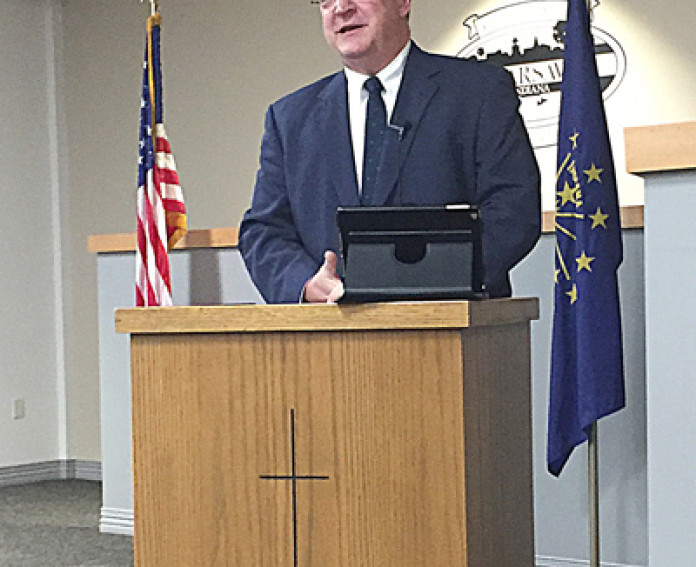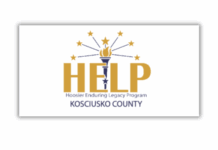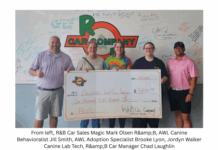During his “state of the city” speech at the end of the Warsaw City Council meeting Monday, Mayor Joe Thallemer talked about what the city accomplished in 2015 and what it will tackle in 2016.
He praised the city departments and their employees as well as the city’s elected officials, highlighted the uniqueness of Warsaw and touched on problems that need addressed.
“As I interact with many fine folks representing cities and towns across the state of Indiana, it’s very apparent to me that what we have here in Warsaw, Indiana, is what many others can only strive for,” Thallemer began. “We’re blessed indeed to live in this community. And that is testimony to the values and work ethic of our citizens, the selfless energy and motivation of our community partners and foresight and tenacity of our homegrown businesses and all of our industrial and commercial partners.”
Population growth is a key indicator of a city’s viability, Thallemer stated. “Today, more people call Warsaw their home than ever.”
Citing the 2014 U.S. Census, Thallemer said Warsaw’s estimated population is 14,280, up 5.3 percent from the 2010 census. In comparison, he said the state has grown at a rate of 1.7 percent in that time.
“A quick check of other Hoosier communities shows that, with the exception of the doughnut counties around Indianapolis, most comparable cities and towns are below the state growth rate of 1.7 percent. The majority of those have shown less than a percent of growth since 2010. Many are going backwards and losing population,” Thallemer said.
While the growth is a “very positive indicator,” he said everyone knows it’s important that “we continue to move forward to grow and build an attractive community, a community that we can continue to be proud of.”
Reviewing 2015, Thallemer paid tribute to two civic leaders who died – Biomet co-founder Dr. Dane Miller and City Councilman Charlie Smith. “Their impact on our city was obvious by the outpouring of sympathy at their loss,” he said, noting their examples as active and engaged community members will be their legacy.
The financial health of Warsaw remains “good,” Thallemer stated.
“The effects of tax caps continues to slow revenue growth while road funding continues to lag woefully behind,” he said. “Careful spending and continued cost savings will allow us to counter those losses.”
For Fiscal Year 2016, the city budget allocation process yielded an increase in the tax rate of only 1 cent, which amounts to a 0.8 percent increase, he continued.
“The council worked hard to keep spending requests down without cutting services, and that small increase was in line with the 2015 rate of inflation of 0.7 percent,” Thallemer said.
Another indicator of the city’s financial health, he said, is that Warsaw “maintained its current bond credit rating this year as a AA- from Standard & Poor’s after recent city securities credit analysis.”
He listed cost-savings measures implemented by the city to reduce spending and increase efficiencies, including the creation of a capital improvement plan developed jointly by department heads to improve efficiencies, share project costs and timelines to eliminate redundancies and reduce costs; instituting a wellness program to further reduce healthcare costs to the city; a new curbside garbage system that will generate savings and increase safety for city employees; and connecting city departments with a fiber network that will generate savings in communication costs and improve efficiencies.
Last year, Gov. Mike Pence established the Regional Cities Initiative program to elevate regionalism “as a key to progressive economic development in our state,” Thallemer said. A competitive program designed to stimulate regional planning and growth, it was highlighted with a $42 million stimulus prize for each of two winning regions. After consideration, Warsaw aligned itself with the Northeast Indiana Region, which includes the Fort Wayne area, though Warsaw continues its ties to the South Bend area. Both the Fort Wayne and South Bend regions were selected as well as a third region.
The opening of the tech park in Warsaw in 2015 was a “banner year in many ways” for the Warsaw Tech Park, Thallemer said. The Certified Tech Park designation by the state was created to promote high-tech manufacturing by stimulating new product development, he explained. It allows the city to collect tax increment from all business activity from within that certified tech park.
“The increment is designated specifically for tech park improvements in the development of an accelerator incubator to nurture new high-tech manufacturing,” Thallemer continued.
In July, a ribbon-cutting was held to open the first phase of expansion in Warsaw Tech Park, which featured a 62,500-square-foot shell building, an extension of Polk Drive, sewer and utility expansion and three shovel-ready sites with fiber. Six weeks later, on Aug. 25, Banner Medical, an orthopedic manufacturer supplier, broke ground on one of those sites to develop a 45,000-square-foot facility, investing over $8 million and adding 76 new high-tech jobs in Warsaw. On Nov. 2, the Warsaw Redevelopment Commission issued tax increment finance district bonds for the third expansion of Winona PVD Coatings, a high-tech non-orthopedic industry, also within the Warsaw Tech Park.
“Those tech park successes we have enjoyed, and the increment revenues generated, will have an even greater impact on the success of the park,” Thallemer said. “The city will explore the development of a Warsaw Tech Park affiliated incubator accelerator in 2016.”
Moving on to roads, he discussed the improvements made to phase one of the East Market Street project and said phase two is currently being engineered; and the Husky Trail-Indiana Department of Transportation project, with its engineering and acquisition being close to completion, and construction could be completed by the end of 2016 or early 2017.
“2016 will also bring discussion of two major transportation initiatives that could affect our citizens,” Thallemer said. “The first is an underpass/overpass traffic solution for the north/south Norfolk & Southern Railroad congestion through our downtown. Delays and bottlenecks caused by slow-moving or stopped trains have not only been a source of inconvenience for Warsaw but an impediment to emergency vehicles and a major traffic safety issue.”
In 2015, a feasibility study looked at engineering solutions and anticipated costs. This year, Thallemer said the city looks forward to evaluating viable cost-effective options “as those results are presented to us.”
In the meantime, Thallemer said INDOT is scheduled to improve five crossings this summer with gate and safety improvements.
The second and larger project is a proposal by the governor’s Blue Ribbon Transportation Panel to improve safety and logistics on U.S. 30, Thallemer said, by making it a “fully controlled access highway.”
He said current at-grade intersections are conflict points that cause “major safety concerns” and slow down commercial truck traffic. “We have seen it here in our community and the congestion will only worsen.”
Truck traffic currently is 15 to 20 percent of the 30,000 vehicles per day on U.S. 30, he said. “That is projected to increase to almost 40,000 per day by 2035 with the percentage of truck traffic almost doubling.”
Warsaw and Kosciusko County have joined the U.S. 30 Coalition of cities and counties to develop “consistency of message” for this project, Thallemer stated. “More important, however, is finding a solution for our local community.”
This year city and county planners will begin looking at options to present to the residential and business communities for their consideration, he said.
“A decision by our local community is much preferred to an INDOT-dictated systemwide solution,” Thallemer said.
The Buffalo Street Legacy TIF bonds are a means to improve vitality and growth. A recommendation from the 2002 Hyett-Palma downtown study was to create a pedestrian link on Buffalo Street from the downtown to Center Lake and Central Park. Thallemer said improved connectivity and walkability will encourage commerce and residential development.
“Work will begin early this summer on the $26 million Buffalo Street redevelopment project. Utility and infrastructure work on the Indiana Street, Buffalo Street connection along with stormwater, sanitation, sidewalk and lighting improvements will be funded by tax increment redevelopment bonds,” Thallemer said.
Construction also is expected to begin later this year on a “unique to Warsaw” residential mix of town homes, city homes and mews. A lakefront plaza with multi-use path connections to the lake and parks, along with a mixed-use blend of small retail shops, will create a focal point to the downtown connection, he continued.
Private investment will fund the housing and mixed-use components of the project. Grant funding also will be sought for the project.
Thallemer talked about the creation of the arts commission fund, the return of Walk-N-Wander, the August air show at the airport, filming of “The Bachelor” and a movie in Warsaw last year and other events that helped or will help promote the city.
He discussed each city department’s accomplishments in 2015 and what they will be working on in 2016.
“I hope it’s apparent our departments are working hard to serve our citizens,” Thallemer said.
He concluded his address by stating, “What makes the city of Warsaw our home is the men, women and children who invest their lives and resources to not only pursue their dreams but for the betterment of their neighbors as well. In that respect, our state of the city is well.”





